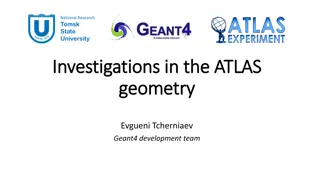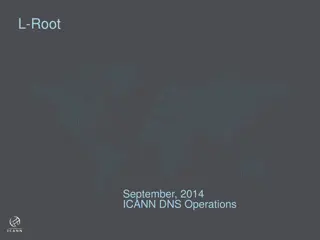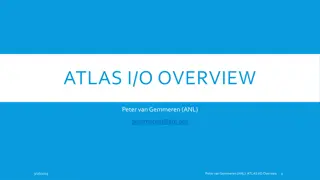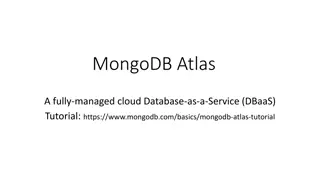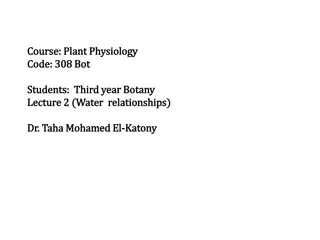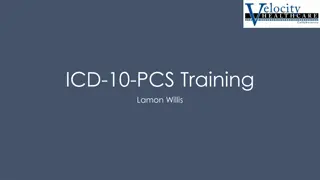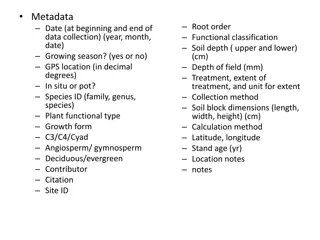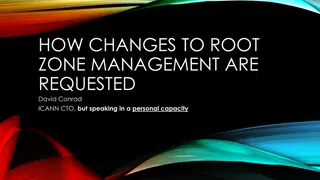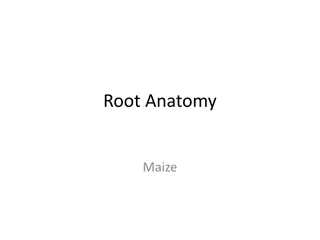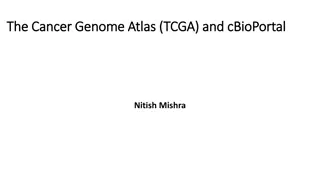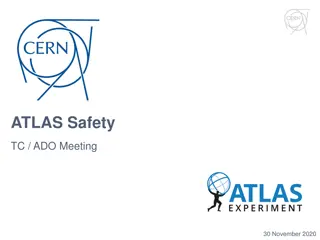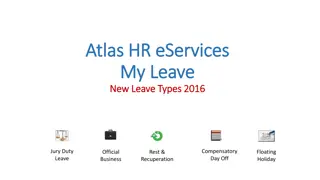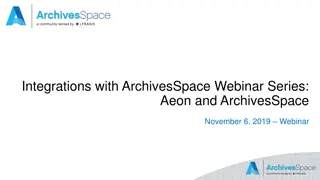Advances in ROOT Functionality for ATLAS I/O Team
Discussion on future ROOT functionality/features by Peter van Gemmeren and Marcin Nowak for the ATLAS I/O team, focusing on interface separation, event data streaming, prototype implementations, memory optimization, and new features for ATLAS EDM xAOD in Run 2.
Uploaded on Sep 24, 2024 | 0 Views
Download Presentation

Please find below an Image/Link to download the presentation.
The content on the website is provided AS IS for your information and personal use only. It may not be sold, licensed, or shared on other websites without obtaining consent from the author. Download presentation by click this link. If you encounter any issues during the download, it is possible that the publisher has removed the file from their server.
E N D
Presentation Transcript
Discussion input for future ROOT functionality/features. Peter van Gemmeren, Marcin Nowak for the ATLAS I/O team
Interface separation of ROOT I/O Dynamic structure creation to minimize ROOT branch count
Event Data Streaming ATLAS is developing Shared Reader/Writer framework for AthenaMP (and others): Worker nodes will not access ROOT file directly. Avoid having multiple worker read (and decompress) same data (because their events are in the same ROOT cluster). Save memory (e.g. TTreeCache). Has to work with fine granularity dispatching (EventServer). Single events for Simulation
Prototype Implementation The (Gaudi-style/ROOT independent) ConversionSvc is configured so that when object is requested from worker s store, it sends a message to a Shared Reader. The Shared Reader uses its ConversionSvc to read the object (via POOL/APR and ROOT) and sends it back via shared memory to the worker.
Okay Read Shared Memory ROOT Request object via Token Worker Reader Object TBranch Object ROOT Reading: Disk I/O De-compress De-serialize Copy Object out Shared Memory: De-serialize Copy Object to Shared Memory: Serialize Serialization Service: (e.g.) ROOT branch->SetAddress() branch->GetEntry()
Better Read Shared Memory ROOT Request object via Token Worker Reader Object TBranch Object ROOT Reading: Disk I/O De-compress De-serialize Copy Object out Shared Memory: De-serialize Copy Object to Shared Memory: Serialize Serialization Service: (e.g.) ROOT branch->SetAddress() branch->GetEntry() branch- >SetBufferAddress () branch->GetEntry()
Please Consider We would like the ROOT team to consider: Provide an interface (similar to SetBufferAddress()) set allows client to read Branch entry w/o de-serialization. This should work for all ROOT data Similarly on write, SetBufferAddress() should allow giving serialized data object to ROOT to collect, compress and write.
Run 2 ATLAS EDM - xAOD For Run2 ATLAS is using a new EDM based on the concept of dynamic data structure xAOD An xAOD type can have a fixed set of static attributes and a random set of dynamic attributes Dynamic attributes can be added at any stage of program execution and removed when writing data to file Data payload changes between event processing stages while the class type remains the same TFile Memory C++ TBranches
xAOD: TBranches and Memory Only dynamic attributes can be dropped between processing stages All attributes that we suspect could be dropped need to be dynamic Every dynamic attribute adds one TBranch ATLAS ESD files can have ~10K branches An open TFile allocates a buffer for each branch Buffer size in memory is multiplied by the compression ration We use a lot of memory
Packing Dynamic Attributes Combining dynamic attributes into a single structure would significantly reduce the number of branches The exact shape of the structure is known only at runtime, when writing data Cannot prepare a dictionary beforehand ROOT offers 2 ways to define a new class on the fly : gSystem->CompileMacro( filename ) Builds and loads a shared library with the class definition Needs to explicitly include all necessary header files Attributes can be of any type! (somewhat slow and less elegant solution) gInterpreter->Declare( C++ class definition ) Fast, knows all types internally But does not produce a TClass with complete reflection information necessary to use StreamerInfo to query about data members
Using Dynamic Structures Declaration Inspecting xAOD dynamic attributes and preparing a string declaration struct xAODtypename_dynamic { // xAOD (Aux) storage vector type attribute name std::vector<int> std::vector<AnyType> *anytype_attr_name = 0; }; *int_attr_name = 0; Creation With TClass::New() Filling A little of void* pointer acrobatics to set all structure members to point to the original xAOD storage vectors Data members offsets seem to follow standard C structure rules (offset 0, 8, 16, ..)
Dynamic Structures I/O Writing Regular TBranch::SetAddress() and Fill() Works as long as all members of the structure have dictionaries Explicit ROOT error if not (good!) Reading ROOT creates the object ( GetEntry() ) Attributes can be inspected using StreamerInfo Data members offsets are completely different than when writing! No idea how to ask ROOT to read directly into xAOD storage (which we do when working with single branches) Currently using a hack to swap std::vector content
Topics for Discussion We are aware we are doing I/O for interpreted types Simple tests are working more testing needed Reading/merging files with different versions of the dynamic structures How to best copy/move the vector payload when reading How to handle new dynamic attributes added after the structure was defined


